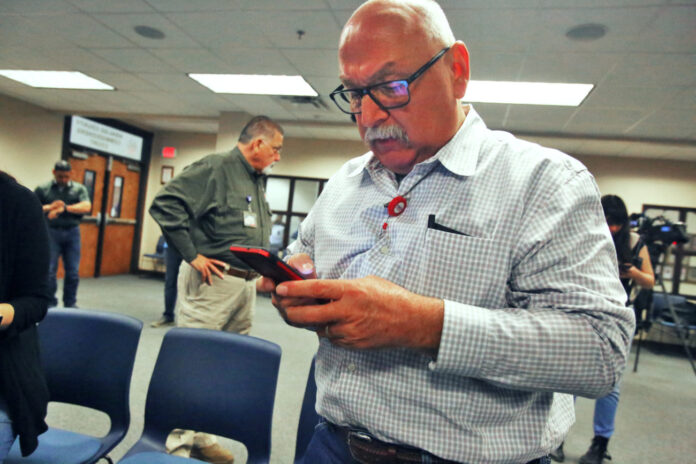The Monitor has lost an effort to learn more about the internal thinking and preparation for COVID-19 between various Hidalgo County health officials.
The newspaper filed a Texas Public Information Act request on March 19, two days before the county reported its first positive case of the virus, in an attempt to learn more about how officials monitored the pandemic’s development and how they prepared for COVID-19 here.
On March 24, the county asked the Texas Attorney General’s Office for an opinion on whether that information was subject to public disclosure.
The county argued that information related to cases or suspected cases of diseases or health conditions that are furnished to a health authority are confidential.
Hidalgo County attorneys also argued that some of the requested information included attorney-client privilege.
The Texas Attorney General’s Office agreed.
In a June 1 letter to the newspaper, the AG says “this office concluded that any information acquired or created during an investigation under chapter 81 of the Health and Safety Code is confidential and may not be released unless an exception set out in the statute applies.”
Based on the county’s representations to the AG, that office determined the county must withhold information falling under this chapter of the Health and Safety Code.
“You claim the remaining responsive information consists of communications between attorneys for the county and county personnel that were made for the purpose of facilitating the rendition of professional legal services to the county,” the letter stated. “You state these communications were intended to be, and have remained, confidential. Based upon your representations and our review, we find you have demonstrated the applicability of the attorney-client privilege to the information at issue.”
Hidalgo County also cited legal reasons in April for why it wasn’t releasing detailed information about COVID-19 cases in nursing homes, despite Cameron County health officials largely being transparent about cases in nursing homes there.
Hidalgo County, however, did have to release some information pertaining to the request that did not fall under either of the above categories.
That information included numerous news releases, publicly available explanatory documents from the Centers for Disease Control about COVID-19 and what officials knew about its spread, communications with courts from the Office of Court Administration and communications between the city of McAllen and county officials regarding events that were going to be postponed.
The county also released a handful of text messages sent by Hidalgo County Health Director Eddie Olivarez.
The first text was sent to an unknown official on Jan. 22, the same day President Donald Trump Jr. first publicly commented on COVID-19’s spread to the United States, telling a CNBC reporter that officials had the virus under control.
In that text, Olivarez wrote: “I wanted to Give you an update on the Wuhan virus from China did in the news no cases and Texas one case in Reynosa it’s contained this is not a deadly illness call me Al answer your questions.”
In late January, COVID-19 had not yet spread throughout the United States. Since it arrived in Hidalgo County in late March, 12 people have died while another 40 people have died in Cameron County. As of press time, three people have died in Willacy County and one has died in Starr County.
Calling COVID-19 the Wuhan virus has since become controversial in public discourse. The virus’ first outbreak was in Wuhan, China.
When asked about Olivarez’s use of the term and whether it’s commonly used in county communication, county spokesman Carlos Sanchez said unequivocally no.
“That was just the contextual evolution of the virus at this time,” Sanchez said. “At the January timeframe media and health advisers across the world were referring to it as the Wuhan virus.”
Olivarez gave officials lessons in not even calling it the coronavirus, Sanchez said.
“At the time there were 11 different strains and the more accurate term was COVID-19 and that is what we have been using,” Sanchez said.
Sanchez was referring to the terminology for COVID-19 evolving from the use of “Wuhan virus” during the early stages of the pandemic, a term which was widely used at one point in media, even in this newspaper’s publication of Associated Press stories.
That short set of text messages includes a redacted section and ends with Olivarez informing the unknown person on March 19 that Cameron County was set to announce its first cases of COVID-19.
Another small set of text messages obtained by the newspaper regarded rumors that swirled in early March that the hospitals were on lockdown because of COVID-19.
“100% sure NO COVID19 cases NO hospitals lockdown – Hospitals Having problems with their Staff on Social Media – systemic problem,” Olivarez said on March 10, 11 days before Hidalgo County’s first positive case.
On March 2, Hidalgo County Health & Human Services issued a notice about spreading false information on social media and said no one in the county has been diagnosed with COVID-19.
“Only the Center for Disease Control can confirm if someone has the virus, not local labs,” the notice on the county’s COVID-19 page read. “Our Health & Human Services Department of the Texas Department of State Health Services will be the one to announce it, if and when the first case of coronavirus occurs in Hidalgo County.”
On March 17, a week after Olivarez’s text, which was to Sanchez, saying there are no cases and lamenting social media problems, Hidalgo County Judge Richard F. Cortez signed the disaster declaration.
The remainder of that short text chain pertains to setting up the county’s COVID-19 website and a television interview.
The Valley has since exceeded the 1,000-case milestone with the majority of deaths reported from all four counties stemming from nursing homes in the area. Officials have recently been warning residents that cases will increase as testing efforts continue to be ramped up.





